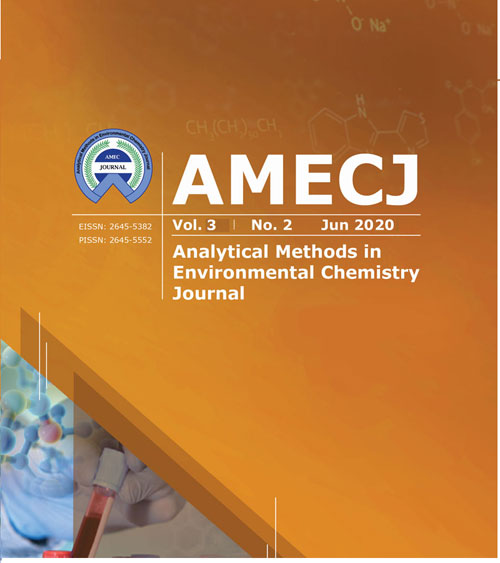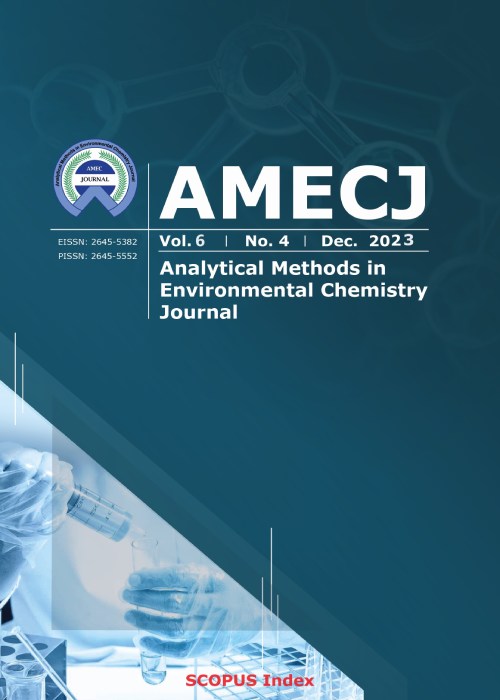فهرست مطالب

Analytical Methods in Environmental Chemistry Journal
Volume:3 Issue: 2, Jun 2020
- تاریخ انتشار: 1399/06/24
- تعداد عناوین: 7
-
Pages 5-20
Mobility of 128 peptides composed of up to 14 amino acids is determined for sodium dodecyl sulfate (SDS) micellar systems using micellar electrokinetic chromatography (MEKC). The mobilities of these peptides are predicted using back propagation of error artificial neural networks (BP-ANNs). Adaptive neuro-fuzzy inference system (ANFIS) which can deal with linear and nonlinear phenomena is used to select the inputs of BP-ANN. A 3:4:1 BP-ANN model with four variables of Kappa substituent constant, Kappa(H), number of peptide bonds, (lnN), molar refractivity of C-terminal, MRC, and steric effects at N-terminal, ES,N, which incorporate substituent, steric and molar refractivity effects as its inputs was developed. Comparison of Multiple Linear Regression (MLR) and ANN results shows the nonlinear characteristic of the phenomena. The nonlinear model was successful in predicting the mobilities of 120 peptides except for the ones (8 peptides) with negatively charged amino acids. It is shown that that most outlier peptides contain middle glutamic acid (E) and aspartic acid (D) amino acids and their mobilities follow a similar mechanism in MEKC.
Keywords: Peptide mobilities, Micellar ElectroKinetic Chromatography, Artificial neural networks, Adaptive neuro-fuzzy inference system -
Pages 21-33
In this work, the occupational analytical chemistry was developed for determination of chronic exposure of mercury in nail and hair in petrochemical workers (Age: 30-50, Men). By experimental procedure, 100 mg of hair and nail of workers was prepared by washing / grinding and then the powder was dried in oven for 20 min at 95oC. 20 mg of hair or nail samples added to reagents (HNO3/H2O2; 5:1) in polyethylene tube (PET) of microwave digestion and the mercury in resulting solution was removed with silver nanoparticles pasted on multi-walled carbon nanotubes (Ag-MWCNTs) which were placed in head space of separator. After microwave digestion for 25 min, the mercury vapor was removed by Ag-MWCNTs as the headspace sorbent trap (HSST) under hood conditions. Finally, the mercury in sorbent was online determined by cold vapor atomic absorption spectrometry (CV-AAS) after heat process at 250oC in presence of Ar gas. The capacity adsorptions of Ag-MWCNTs and MWCNTs for mercury removal from air were obtained 205.4 mg g-1 and 63.7 mg g-1, respectively. The mean of mercury in nail and hair in workers and healthy peoples was achieved (15.2±3.7 μg g-1; 11.6± 2.6 μg g-1) and (0.16±0.05 μg g-1; 0.24± 0.03 μg g-1), respectively (RSD<5%). The validation of method was done by certified reference material (CRM).
Keywords: Mercury, Nail, Hair, Silver multi-walled carbon nanotubes, Microwave-assisted headspace removal -
Pages 34-58
The volatile organic compounds (VOCs) have toxic effects on human health and environmental matrices. So, determination and removal of VOCs from the environmental samples such as water, wastewater and air are very important as they exert toxic effects on human. Many chemical techniques such as; analytical methods for sorbents (extraction, adsorption), sole gel method, pervaporation, regenerative catalytic oxidation (RCO), recuperative catalytic oxidation (CO), adsorptive concentration-catalytic oxidation, photocatalytic oxidation (PCO), ozonation-catalytic oxidation and non-thermal plasma-catalytic oxidation, have been used for removal and reduction of VOCs from different matrices. This review study has been conducted to collect the adsorbents and applied chemistry methods which have been recently used in different works for the elimination of VOCs from air and water samples.
Keywords: Volatile organic compounds, Chemistry, biochemistry method, Removal, Adsorption, Water, air -
Pages 59-73
A novel sorbent based on MIL-101(Cr) nanoadsorbent as a MOF structure was used for nickel extraction from water and wastewater samples. In this study, 30 mg of MIL-101(Cr) nanoadsorbent dispersed in 50 mL of water or wastewater samples, after sonication and adjusting pH =8.5, the nickel ions was extracted by carboxyl groups of terephthalic acid (MOF─(C6H4 (COO)2-.... Ni2+) by dispersive suspension-micro solid-phase extraction (DS-μ-SPE). The MOF was separated from liquid phase with filter membrane (0.2 μm), eluted with 0.5 mL of nitric acid as back-extraction solution and finally, the nickel concentration in elution was determined by atom trap-flame atomic absorption spectrometry (AT-FAAS) after dilution with DW up to 1 mL. The LOD, the linear range and preconcentration factor were achieved 1.5 μg L−1, 5-160 μg L−1 and 49.7, respectively. The absorption capacity of MOF for nickel was obtained 136.8 mg g-1. The results of procedure were validated by spiking of samples and ET-AAS analyzer.
Keywords: MIL-101(Cr) nanoadsorbent, Nickel, Water, wastewaters, Dispersive suspension micro solid phase extraction, Atom trap-flame atomic absorption spectrometry -
Pages 74-81
The nano-sized structure of well-ordered Zn@MCM-41 adsorbent was synthesized through a direct hydrothermal method using CTAB as a structure-directing agent in an ammonia aqueous solution with different amounts of zinc acetylacetonate which were inserted into the structure-directing agent’s loop during the synthesis. The XRD, HRTEM, and N2 adsorption-desorption isotherms were used to characterize the prepared ZnO functionalized mesoporous silica samples. As a result, the presence of ZnO in highly-ordered MCM-41’s pore was proved as well as maintenance of the ordered meso-structure of MCM-41. The materials were possessed with a high specific surface area (1114-509 m2 g-1) and a large pore diameter (4.03-3.27 nm). Based on the obtained results from the adsorption of H2S gas in a lab-made setup, the Znx@MCM-41 showed the superior ability to increase of ZnO amount up to 7 hours as a breakthrough point. A two factor (zinc percent and temperature) experimental design with three levels was accomplished to optimize the adsorption parameters. The influence of parameters and the interactions on the adsorption of H2S were studied and optimized. Also, the H2S breakpoint curves carried on by UOP163 method.
Keywords: Zinc encapsulated MCM-41, H2S gas, Adsorption, Extraction, UOP163 method -
Pages 82-91
A new method for aluminum extraction from drinking water and human serum samples was used by djenkolic acid (DJKA) immobilized on multi walled carbon nanotubes (MWCNTs-DJKA). By procedure, the mixture of 25 mg of MWCNTs-DJKA sorbent and hydrophobic ionic liquid ([OMIM][PF6]) were dispersed with ultrasonic bath in 10 mL of drinking water and serum samples for 10 min at pH=5. The aluminum ions were extracted based on MWCNTs-DJKA sorbent in liquid phase by ultrasound-assisted dispersive micro solid phase extraction (USA-D-μ-SPE). After centrifuging, the Al (III) was separated from liquid phase by ionic liquid phase in bottom of centrifuge PVC tube. Finally, the Al (III) were back-extracted from sorbent/IL in acidic pH and measured by electrothermal atomic absorption spectrometry (ET-AAS). In optimized study, LOD, LOQ, the linear range, the working range and the enrichment factor were obtained 0.1 μg L−1, 0.3 μg L−1, 0.3-12.8 μg L−1, 0.3-30.7 μg L−1 and 9.92, respectively (RSD< 5%). The adsorption capacity of the MWCNTs-DJKA sorbent was obtained in batch system. Based on proposed procedure, the mean concentrations of aluminum in drinking waters and serum samples were lower than world health organization (WHO) and American conference of governmental industrial hygienists (ACGIH) references. The method was validated by spiking samples and standard reference materials (SRM) in water and human biological samples.
Keywords: Aluminum, Poly methyl ether thiol sorbent, Dispersive micro solid phase extraction, Waters, Human serum, Electrothermal atomic absorption spectrometry -
Pages 92-107
The aim of this article was the fabrication of zeolite@Pd/Al2O3nanostructure through roll-coating technique for CO gas adsorption from air. Transmission electron microscopy (TEM), field-emission scanning electron microscopy (FESEM), X-ray diffraction (XRD), and energy-dispersive x-ray spectroscopy (EDX) were performed to investigate the morphological, structural, and elemental properties of zeolite@Pd/Al2O3adsorbent. A continues carbon monoxide gas analyzer KIGAZ 210 was applied for analyzing of CO gas adsorption on as-present adsorbent in an experimental set-up. The adsorption capacity at equilibrium time for COmolecules was studied by zeolite@Pd/Al2O3adsorbent. The Elovich, Avrami, and Fractional power kinetic models were used for this study. The equal value of experimental and theoretical adsorption capacity at equilibrium time as well as the unit value of regression coefficient was indicated that the Avrami kinetic model was the suitable model to describe CO removal from air through zeolite@Pd/Al2O3nanostructure. The results showed us, the COmolecules were efficiently removed by catalytic zeolite adsorbent more than 95% from air at optimized conditions.
Keywords: Carbon monoxide (CO), Toxic gas analysis, Adsorption, Alumina palladium zeolite composite films, Kinetic models


